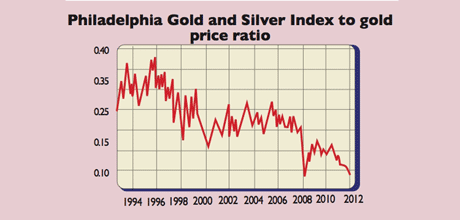
According to at least one key measure, gold mining shares are as cheap as at any time in the last 30 years. The ratio between the Philadelphia Gold and Silver Index (XAU) and the gold price recently dipped below 0.1, a level it’s seen only once before, during the depths of the late-2008 crisis. Sounds good. But picking gold mining winners is notoriously hard. So to gain simple, diversified exposure to the sector as a whole, it’s worth considering an exchange-traded fund (ETF).
For UK-based investors, three ETFs fit the bill: iShares’ S&P Commodity Producers Gold ETF (LSE: SPGP), ETF Exchange’s DaxGlobal Gold Mining Fund (LSE: AUCO, AUCP – for listings in dollars and sterling, respectively) and the RBS Market Access NYSE Arca Gold Bugs Index ETF (LSE: GOLB). But which should you buy?
The first thing to check with ETFs is the underlying index. The Gold Bugs index tracked by the RBS ETF includes only stocks that don’t hedge (sell forward) their output. Ten years ago, most miners did hedge, and many lost out on huge gold price gains. Unsurprisingly, hedging isn’t now widely undertaken and, as a result, the indices tracked by the three ETFs resemble each other, at least when it comes to the top holdings. SPGP and AUCO have longer “tails” of smaller stocks than GOLB, however.
SPGP charges less in annual expenses (0.55%) than AUCO (0.65%) and GOLB (0.7%). AUCO and GOLB also charge swap spreads of around 30 and ten basis points a year, respectively. Swap spreads are a variable payment to the counterparty providing the index return to the fund and will be reflected in the fund’s tracking difference against the index.
Of the three funds, GOLB is the largest, with $200m under management, compared with AUCO’s $78m and SPGB’s $45m. According to the London Stock Exchange, GOLB also tends to trade with tighter bid-offer spreads than the other two, at around 0.8% on average for a round-trip trade, against 1%-2% for AUCO and SPGB.
As most of the indices’ underlying stocks are traded in America, make sure you buy and sell after 2.30pm London time, when spreads will be tighter, and consider using a limit order to control trading costs. If you’re looking to hold longer-term, SPGP’s lower costs argue for buying the iShares fund. If you’re a more regular trader, we’d recommend you go with RBS Market Access’s GOLB.
• Paul Amery edits
www.indexuniverse.eu
, the top source of news and analyses on Europe’s ETF and index-fund market.